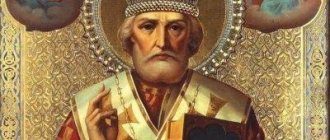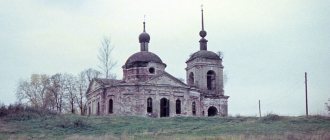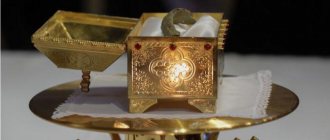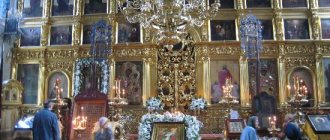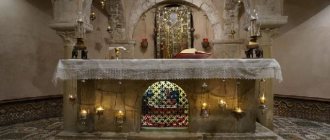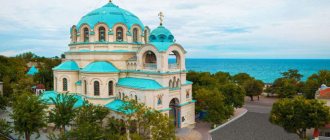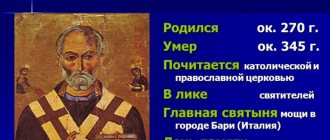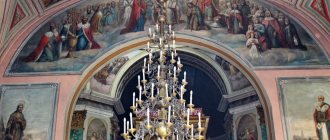HISTORICAL REFERENCE
| The parish of the Church of St. Nicholas of Myra in Pyzhi has been known since 1625. The modern building of the two-altar church was built in 1672. The main altar is consecrated in honor of the Annunciation of the Most Holy Theotokos, the chapel is dedicated to St. Nicholas of Myra. During the years of persecution, the parish was deregistered, and the church was closed for worship and transferred to the national economy in 1934. Before closing, the following served in the church: the venerable confessor Gabriel (Igoshkin), the martyr Nikolai Safonov, and the martyr Tatyana Grimblit. In 1990, the parish of the temple was revived and received legal registration. In the same year, the former church building was transferred to the parish. In 1992, the consecration of the Nikolsky chapel took place by His Holiness Patriarch Alexy II of Moscow and All Rus'. |
SACRED TEMPLE
Reliquary cross with the relics of many saints of the Universal Church. The image of the passion-bearer Tsar Nicholas II, as well as the icon of the holy Royal passion-bearers.
WORSHIP
On Sundays, as well as on the days of great, twelfth and patronal feasts, two Divine Liturgies are celebrated - at 7.00 and at 10.00. On other days, the Divine Liturgy begins at 8.00. The evening service begins at 18.00. On Sunday evening, an akathist to the Sweetest Jesus or an akathist for the holiday is performed; on Wednesday evening, akathists are performed alternately to St. Nicholas the Wonderworker and St. To the Passion-Bearer Tsar Nicholas II.
CLERGY
| Archpriest Alexander Ivanovich SHARGUNOV, rector. Born December 31, 1940. Education: Moscow State Institute of Fine Arts named after. M. Thorez, Moscow Theological Seminary, Moscow Theological Academy. Candidate of Theology. On March 27, 1977, he was ordained to the rank of deacon. On May 21, 1977 he was ordained to the priesthood. On November 13, 1990, he was appointed rector of the temple. |
| Archpriest Valery Vladimirovich GURIN, full-time clergyman of the church parish. Born September 24, 1964. Education: secondary. On April 18, 1992 he was ordained to the rank of deacon. On February 14, 1993 he was ordained to the priesthood. |
| Priest Alexy Viktorovich KORSHUNOV, full-time clergyman of the church parish. Born September 12, 1972. Education: Moscow State University of Veterinary Medicine and Biotechnology, Moscow Theological Seminary. On May 22, 2000, he was ordained to the rank of deacon. On September 21, 2006, he was ordained to the priesthood. |
| Deacon Andrey Nikolaevich DEMCHENKO, full-time clergyman of the church parish. Born September 13, 1973. Education: Voskresensk Construction College. Kolomna Theological Seminary. On November 7, 2010, he was ordained to the rank of deacon. |
DIRECTIONS Directions to the station. m. "Tretyakovskaya". Exit to the street Bolshaya Ordynka. Walk 1-2 minutes away from the center. The church has children's and adult Sunday schools, an Orthodox military club "Sim Victory", and a correspondence Sunday school for prisoners.
Church of St. Nicholas in Pyzhi
Date of publication or update 04.11.2017
To the table of contents - Moscow churches
- Prayer to Saint Nicholas, Miracle Worker of Myra
- Prayer to Saint Nicholas (for travelers)
- The Life of Saint and Wonderworker Nicholas, Archbishop of Myra (from the “Lives of the Saints” by St. Demetrius of Rostov).
- Life (short) of St. Nicholas the Wonderworker.
Built: 1672 Temple address: 109017, Moscow, st. B. Ordynka, 27a/8 (metro stations "Tretyakovskaya", "Novokuznetskaya"). Directions: st. Tretyakovskaya metro station, then walk along the street. Bolshaya Ordynka in the direction from the center. Temple telephone, fax Church website: https://www.vpyzhax.ru Altars: main - Annunciation of the Blessed Virgin Mary, chapel - St. Nicholas the Wonderworker, side throne - sschmch. Vladimir of Kyiv, All New Martyrs and Confessors of Russia.
History: The church was built by the archers of Bogdan Pyzhov’s regiment in 1670 - 1672. on the site of a wooden temple, known since 1635.
The general composition of the temple is typical for townsfolk churches of that time: the double-height quadrangle is completed with a hill of kokoshniks and crowned with a five-domed structure that has preserved the original openwork crosses.
The refectory with a warm aisle and the three-tier bell tower were built in 1691 - 1692.
In 1811, on the south side of the refectory, the Nikolsky chapel was built, designed in the forms of classicism.
In 1886, with the help of philanthropists, a one-class parochial school was opened, where students of the 5th and 6th grades of the Mariinsky Diocesan School did internships.
In the 19th century The temple was renovated with funds from the Lyamin and Rakhmanin families.
The church was closed from 1934 to 1991, and the building was occupied by various institutions.
Divine services resumed in July 1991.
Currently, there are Sunday and choir schools at the church.
Shrines: in the church there are particles of the relics of the Holy Spirit. Grand Duchess Elizabeth, St. Tikhon, Patriarch of Moscow, St. John the Baptist, Prophet Isaiah, App. Mark, Luke and Andrew the First-Called, Archdeacon Stephen, Equal to the Apostles. Princess Olga, right. Anna, St. Silouan of Athos and others; the myrrh-streaming icon of the passion-bearer Tsar Nicholas II, the pectoral cross of the warrior-new martyr Yevgeny Rodionov and other shrines. Days of remembrance: December 6/19, May 9/22 Divine services: daily - Liturgy at 8 o'clock, evening at 17 o'clock. (in the summer at 18:00), on Wednesdays - from akaf. St. Nicholas and Tsar-Martyr Nicholas alternately, on Sundays and holidays - Liturgy at 7 and 10 o'clock, the day before all-night vigil at 17 (18) o'clock. Blessings of water and other prayers - daily after the Liturgy. On Sundays, for a festive prayer service, reliquaries with relics are taken out of the altar.
Pilgrim[edit]
Schedule of services:
On Sundays, as well as on the days of great, twelfth and patronal feasts, two Divine Liturgies are celebrated - at 7.00 and at 10.00.
On other days, the Divine Liturgy begins at 8.00. The evening service begins at 18.00.
On Sunday evening, an akathist to the Sweetest Jesus or an akathist for the holiday is performed; on Wednesday evening, akathists are performed alternately to St. Nicholas the Wonderworker and St. To the Passion-Bearer Tsar Nicholas II.
Current schedule of services
Church of St. Nicholas in Pyzhi
This term has other meanings, see Church of St. Nicholas. This term has other meanings, see Church of St. Nicholas.
architectural monument (federal)
Orthodox church
Church of St. Nicholas in PyzhiCountryRussia
CityMoscow
ConfessionOrthodoxy
DioceseMoscow
Building typeChurch
Date of foundation16th century
Construction1657-1672
StatusObject of cultural heritage of the peoples of the Russian Federation of federal significance. Reg. No. 771610723540006 (EGROKN). Object No. 7710546000 (WikiGida DB)
Statevalid
WebsiteMedia files on Wikimedia Commons
The Church of St. Nicholas in Pyzhi is an Orthodox church of the Moskvoretsky deanery of the Moscow diocese; architectural monument of the 17th century.
The temple is located in the Zamoskvorechye district of Moscow at the address: Bolshaya Ordynka Street, No. 27/6. It stands between Bolshaya and Malaya Ordynka; Near it there is a two-story clergy house - an architectural monument of the 19th century, architect Alexander Nikiforov (1890).
The rector is Mitred Archpriest Alexander Shargunov.
Shrines
The temple has a reliquary in the shape of a cross, which contains the relics of seventy-two saints of the Universal Church. List of main shrines:
- Myrrh-streaming image of the passion-bearer Tsar Nicholas II;
- Particles of the relics of John the Baptist;
- Icon of the Holy Royal Martyrs. The reliquary of the shrine contains the milk tooth of Tsarevich Alexei;
- Particles of the relics of the Apostle Andrew the First-Called;
- Particles of the relics of the Apostle Luke;
- Particles of the relics of the Apostle Mark;
- Particles of the relics of St. Silouan of Athos;
- Particles of the relics of Righteous Anna;
- Particles of the relics of the prophet Isaiah;
- Particles of the relics of Equal-to-the-Apostles Princess Olga;
- Particles of the relics of Archdeacon Stephen.
© Official Facebook group of the Church of St. Nicholas in Pyzhi
Story
Photo by Nikolai Naydenov, 1882
The wooden church on the site of the current one was founded no earlier than 1593, probably simultaneously with the establishment of the Streltsy settlement. In the second half of the 17th century, the local rifle regiment was commanded by Bogdan Pyzhov, who gave his name to the area, the temple and Pyzhevsky Lane. The construction of the main volume of the Annunciation Church dates back to 1672 (according to other sources, 1657). In 1691, chapels were built in honor of Anthony and Theodosius of Pechersk and in honor of St. Nicholas, whose name has since become the main one for “Nicholas in Pyzhi”. After the destruction in 1812, the temple was restored, starting in 1848, with the money of the Lyamin merchants.
The temple was closed in 1934, the last rector before the closure was the Rev. Confessor Gabriel (Igoshkin, 1888-1959). The temple was returned to the Russian Orthodox Church in 1990, services began in 1991. The iconostasis is modern, the work of I. V. Klimenko; in the Nikolsky chapel there are paintings of the late 19th century by A. Sokolov.
Years of total atheism
But the main trials lay ahead for the temple, when in the coming 20th century, power in the country was seized by an atheistic government. In 1934, the temple was closed, and many of its priests and parishioners were repressed. Suffice it to say that three of his clergy were subsequently canonized as new martyrs and confessors of Russia.
St. Nicholas Church was partly lucky in that it was not destroyed, like so many of its Moscow counterparts, and after internal redevelopment it was used for various economic needs. The main aisle of the temple was divided into three floors, and in the premises thus formed, first there was a dormitory for the construction trust, then a scientific and technical laboratory, and finally sewing workshops.
Architectural features
A peculiarity of the church is the layout of its two chapels, “pushed” into the northeastern and southeastern corners of the main cubic volume and almost obscured by the wide semicircles of their apses, which, being equal in size and located on the same line with the apse of the altar of the main temple, look like a traditional three-part apse . The slender hipped bell tower with a superbly decorated “hanging” entrance arch belongs to the best examples of this type of structure in Moscow architecture. The refectory and bell tower adjacent to the temple are placed along the main axis, that is, “ship”, as they began to do in the second half of the 17th century. A typical five-domed, pillarless temple with a developed lush entablature and tiers of kokoshniks, richly decorated with “piece set” brick details.
> Clergy
Church of St. Nicholas in Pyzhi
The Streletsky Regiment has been known since the 1650s, when it was commanded by Vasily Ivanovich Filosofov. In 1668 he was replaced by Bogdan Pyzhov. The Sagittarius of Bogdan Pyzhov built this temple in stone in 1657 (different sources say the year is 1670). The temple had two chapels: in honor of St. Nicholas the Wonderworker and in honor of the Monks Anthony and Theodosius of Pechersk. According to Moscow tradition, churches were often named after their side chapels, the church is known as Nikolskaya, and the main altar was consecrated in the name of the Annunciation
Under the command of Pyzhov, the regiment distinguished itself in the campaign against the “Zaporozhye Cherkassy” of Hetman I. M. Bryukhovetsky in 1668, against Stenka Razin two years later, and then fought against the Zayitsky Cossacks. And in 1682, the archers filed a petition to the sovereign against their colonel Bogdan Pyzhov, accusing him of illegally deducting money from their salaries. That, they say, “he deducted half the salary, and for others even more.” Boyar Ioann Yazykov, who conducted the investigation, decided the case in favor of the authorities and the petitioners were severely punished: they were beaten with a whip and sent into exile. However, the archers believed that Yazykov conducted the investigation “unjustly.” Pyzhov's removal from command indirectly proves their rightness. In February 1682, he was sent by the governor to the distant Vyatka town of Kaigorod.
This link may have saved Pyzhov. After all, in 1698 there was an uprising of the Moscow Streltsy regiments, during the pacification of which several thousand Streltsy were hanged. Bogdan Pyzhov could have laid his head there. He would have been killed either by the archers or Peter’s troops.
In 1692, the archers added a bell tower to the church.
In 1811, the southern Nikolsky chapel was built and at the same time the refectory was reconstructed - the height of the refectory vault was increased. And in 1812, the church was destroyed by the French troops of Napoleon Bonaparte.
Since 1858, for almost half a century, the famous merchants Lyamina who lived nearby took care of the temple. I. A. Lyamin was the churchwarden of the parish.
The temple stands in the depths of the site behind a lattice fence. A double-height quadrangle culminating in a wave of kokoshniks peeks out from behind the trees, and five domes of the temple rise above. The wealth of decorative decoration, rare even for the 17th century, is impressive. All the windows on the northern façade have different frames with fine stone carvings. The design of the western portal of the refectory is remarkable with garlands of carved archivolts and carved columns, the bases of which are identical to the capitals, as was customary at the end of the 17th century. There are 16 dormers in the slender hipped bell tower,
the ringing of its bells was heard throughout Zamoskvorechye. The temple fence was made at the end of the 19th century.
The Bolsheviks destroyed the temple in 1922, and in 1930 they closed it altogether. The icons were given to the Tretyakov Gallery, and the bell was transferred to the Bolshoi Theater, where it rang during the performance of the opera “Boris Godunov”. Then he was hanged in the Epiphany Cathedral in Yelokhov.
In 1960, the temple was restored. Research institutes and workshops were later located there. In 1990, the temple was returned to believers.
Tags:
- 17th century
- 19th century
- pentacephalus
- temple
Church of St. Nicholas in Pyzhi, Moscow
- Tourism in Moscow
- Moscow Hotels
- Bed and Breakfast Moscow
- Moscow Tour Packages
- Flights to Moscow
- Moscow Restaurants
- Entertainment in Moscow
- Moscow: shops
- Moscow Travel Forum
- Moscow Photos
- Moscow map
- All Moscow hotels
- 5-stars Hotels in Moscow
- Marriott Hotels in Moscow
- Moscow Hotels with Pools
- 3rd Transport Ring (TTK) Hotels
- City Center Hotels in Moscow
- Hotels near Church of St. Nicholas in Pyzhi
- Hotels near (SVO) Sheremetyevo Airport
- All Moscow restaurants
- All things to do in Moscow
- Church of the Holy Great Martyr Catherine on Vspolye
- Moscow: Bridges
- Fun & Games in Moscow Playgrounds in Moscow
- Art Galleries in Moscow
- Bus Tours in Moscow
- Art Galleries in Moscow
- Bars & Clubs in Moscow
- Moscow: Spa
- Blues Clubs & Bars in Moscow
- Moscow: Beach & Pool Clubs
- Playgrounds in Moscow
- Sports Camps & Clinics in Moscow
- Moscow: Trams
- Wineries & Vineyards in Moscow
- Water Sports in Moscow
- Convention Centers in Moscow
- Aquariums in Moscow
- Adventures
- Guides


